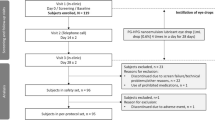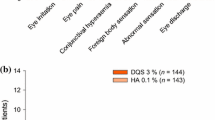Abstract
Objective|
The objective of this review is to evaluate the safety and efficacy of polyethylene glycol 400/propylene glycol/hydroxypropyl-guar (Systane® Ultra [PEG/PG with HP-guar], Alcon Laboratories, Inc., Fort Worth, TX, USA) lubricant eye drops in reducing the signs and symptoms of dry-eye disease.
Methods|
A systematic literature search utilizing MEDLINE was conducted to identify peer-reviewed articles related to dry-eye disease and PEG/PG with HP-guar lubricant eye drops. The search covered the period prior to October 2009. Additionally, a manual search based on citations in the published literature was conducted.
Results|
The PEG/PG with HP-guar artificial tears shows in-vitro viscoelastic properties with pH optimization. The pH of the solution adjusts to the pH of the ocular surface upon instillation, which results in tear film elasticity and viscosity similar to that of subjects without dry-eye disease. The reviewed literature demonstrated that this delivery system showed a reduction in corneal and conjunctival staining in dryeye disease, an improvement in tear film stability, a low coefficient of friction in an in-vitro model, and improved maintenance of best-corrected visual acuity over time.
Conclusion|
A few small-sized studies with short-term follow-up demonstrated that PEG/PG with HP-guar is a safe and effective lubricant eye drops for the treatment of dry-eye disease. Larger studies with longer duration are warranted to assess the long-term safety and efficacy of this formulation in patients with dry.eye disease.
Similar content being viewed by others
References
Lemp MA, Foulks GN. The definition and classification of dry eye disease: report of the Definition and Classification Subcommittee of the International Dry Eye WorkShop (2007). Ocul Surf. 2007;5:75–92.
McCarty CA, Bansal AK, Livingston PM, Stanislavsky YL, Taylor HR. The epidemiology of dry eye in Melbourne, Australia. Ophthalmology. 1998;105:1114–1119.
Schein OD, Munoz B, Tielsch JM, Bandeen-Roche K, West S. Prevalence of dry eye among the elderly. Am J Ophthalmol. 1997;124:723–728.
Doughty MJ, Fonn D, Richter D, Simpson T, Caffery B, Gordon K. A patient questionnaire approach to estimating the prevalence of dry eye symptoms in patients presenting to optometric practices across Canada. Optom Vis Sci. 1997;74:624–631.
Schaumberg DA, Sullivan DA, Buring JE, Dana MR. Prevalence of dry eye syndrome among US women. Am J Ophthalmol. 2003;136:318–326.
Lemp MA, Foulks G, Devgan U, et al. The therapeutic role of lipids: managing ocular surface disease. Refract Eyecare Ophthalmol. 2005;9:3–15.
Moss SE, Klein R, Klein BE. Prevalence of and risk factors for dry eye syndrome. Arch Ophthalmol. 2000;118:1264–1268.
Perry HD, Donnenfeld ED. Dry eye diagnosis and management in 2004. Curr Opin Ophthalmol. 2004;15:299–304.
Altinors DD, Akca S, Akova YA, et al. Smoking associated with damage to the lipid layer of the ocular surface. Am J Ophthalmol. 2006;141:1016–1021.
Schlote T, Kadner G, Freudenthaler N. Marked reduction and distinct patterns of eye blinking in patients with moderately dry eyes during video display terminal use. Graefes Arch Clin Exp Ophthalmol. 2004;242:306–312.
Gifford P, Evans BJ, Morris J. A clinical evaluation of Systane. Cont Lens Anterior Eye. 2006;29:31–40.
Schiffman RM, Christianson MD, Jacobsen G, Hirsch JD, Reis BL. Reliability and validity of the Ocular Surface Disease Index. Arch Ophthalmol. 2000;118:615–621.
Kahook MY, Springs C. Treating ocular surface disease in glaucoma. Glaucoma Today. 2008;11.
Mertzanis P, Abetz L, Rajagopalan K, et al. The relative burden of dry eye in patients’ lives: comparisons to a US normative sample. Invest Ophthalmol Vis Sci. 2005;46:46–50.
Kozma CM, Hirsch JD, Wojcik AR. Economic and quality of life impact of dry eye symptoms. Poster presented at the Annual Meeting of the Association for Research in Vision and Ophthalmology, April 30–May 5, 2000, Ft. Lauderdale, Fla.
Tuft S, Lakhani S. Medical management of dry eye disease. Dev Ophthalmol. 2008;41:54–74.
Foulks GN. Clinical evaluation of the efficacy of PEG/PG lubricant eye drops with gelling agent (HP-guar) for the relief of the signs and symptoms of dry eye disease: a review. Drugs Today (Barc). 2007;43:887–896.
Bron AJ, Tiffany JM, Gouveia SM, Yokoi N, Voon LW. Functional aspects of the tear film lipid layer. Exp Eye Res. 2004;78:347–360.
Lemp MA. Report of the National Eye Institute/ Industry workshop on Clinical Trials in Dry Eyes. CLAO J. 1995;21:221–232.
Stern ME, Beuerman RW, Fox RI, Gao J, Mircheff AK, Pflugfelder SC. The pathology of dry eye: the interaction between the ocular surface and lacrimal glands. Cornea. 1998;17:584–589.
Terry MA. Dry eye in the elderly. Drugs Aging. 2001;18:101–107.
Tomlinson A, Khanal S, Ramaesh K, Diaper C, McFadyen A. Tear film osmolarity: determination of a referent for dry eye diagnosis. Invest Ophthalmol Vis Sci. 2006;47:4309–4315.
Khanal S, Tomlinson A, McFadyen A, Diaper C, Ramaesh K. Dry eye diagnosis. Invest Ophthalmol Vis Sci. 2008;49:1407–1414.
Wolkoff P, Nojgaard JK, Troiano P, Piccoli B. Eye complaints in the office environment: precorneal tear film integrity influenced by eye blinking efficiency. Occup Environ Med. 2005;62:4–12.
Ousler GW, Michaelson C, Christensen MT. An evaluation of tear film breakup time extension and ocular protection index scores among three marketed lubricant eye drops. Cornea. 2007;26:949–952.
Torkildsen G. The effects of lubricant eye drops on visual function as measured by the inter-blink interval visual acuity decay test. Clin Ophthalmol. 2009;3:501–506.
Freudenthaler N, Neuf H, Kadner G, Schlote T. Characteristics of spontaneous eyeblink activity during video display terminal use in healthy volunteers. Graefes Arch Clin Exp Ophthalmol. 2003;241:914–920.
Berke A. Blinking frequence and the the thickness of the lipid layer. In: Sullivan DA, Stern GA, Dartt DA, Sullivan RM, Bromberg BB, eds. Lacrimal Gland, Tear Film, and Dry Eye Syndrome 3. New York: Kluwer Academic/Plenum; 2002:513–516.
Petricek I, Berta A, Higazy MT, Nemeth J, Prost ME. Hydroxypropyl-guar gellable lubricant eye drops for dry eye treatment. Expert Opin Pharmacother. 2008;9:1431–1436.
Tiffany JM. Measurement of wettability of the corneal epithelium. II. Contact angle method. Acta Ophthalmol (Copenh). 1990;68:182–187.
American Academy of Ophthalmology. The Eye M.D. Association. American Academy of Ophthalmology Basic and Clinical Science Course, 2005–2006. Section 13, Refractive Surgery, page 5.
Rolando M, Zierhut M. The ocular surface and tear film and their dysfunction in dry eye disease. Surv Ophthalmol. 2001;45(suppl. 2):S203–S210.
Montés-Micó R, Caliz A, Alio JL. Changes in ocular aberrations after instillation of artificial tears in dryeye patients. J Cataract Refract Surg. 2004;30:1649–1652.
Montés-Micó R, Caliz A, Alio JL. Wavefront analysis of higher order aberrations in dry eye patients. J Refract Surg. 2004;20:243–247.
Montés-Micó R, Alio JL, Munoz G, Charman WN. Temporal changes in optical quality of air-tear film interface at anterior cornea after blink. Invest Ophthalmol Vis Sci. 2004;45:1752–1757.
Montés-Micó R, Alio JL, Munoz G, Perez-Santonja JJ, Charman WN. Postblink changes in total and corneal ocular aberrations. Ophthalmology. 2004;111:758–767.
Toyos R. Ability of Systane Ultra to reduce transient visual degradation. Presented at: American Society for Cataract and Refractive Surgery. April 7–9, 2010; Boston, MA, USA.
Huang FC, Tseng SH, Shih MH, Chen FK. Effect of artificial tears on corneal surface regularity, contrast sensitivity, and glare disability in dry eyes. Ophthalmology. 2002;109:1934–1940.
Rolando M, Iester M, Macri A, Calabria G. Low spatial-contrast sensitivity in dry eyes. Cornea. 1998;17:376–379.
Behrens A, Doyle JJ, Stern L, et al. Dysfunctional tear syndrome: a Delphi approach to treatment recommendations. Cornea. 2006;25:900–907.
Lopez BD, Ubels JL. Artificial tear composition and promotion of recovery of the damaged corneal epithelium. Cornea. 1993;12:115–120.
Lopez BD, Ubels JL. Quantitative evaluation of the corneal epithelial barrier: effect of artificial tears and preservatives. Curr Eye Res. 1991;10:645–656.
Davitt WF, Blooenstein M, Martin A, Christensen MT, Martin AE. Efficacy in patients with dry eye after treatment with a new lubricant eye drop formulation. J Ocular Pharmacol Therap. 2010. In press.
Hartstein I, Khwarg S, Przydryga J. An openlabel evaluation of HP-guar gellable lubricant eye drops for the improvement of dry eye signs and symptoms in a moderate dry eye adult population. Curr Med Res Opin. 2005;21:255–260.
Ketelson HA, Davis J, Meadows DL. Characterization of a novel polymeric artificial tear delivery system. Presented at: The Association for Research in Vision and Ophthalmology (ARVO). April 27–May 1, 2008. Fort Lauderdale, Florida, USA.
Kading D. A two-week clinical evaluation of the safety of Systane Ultra in contact lens-wearing patients. Clin Ophthalmol. 2010;4:27–32.
Springs C. Novel ocular lubricant containing an intelligent delivery system: details of its mechanism of action. In: Brewitt H, ed. Research Project in Dry Eye. Basel: Kager; 2010:139–147.
Korb DR, Greiner JV, Herman JP, et al. Lid-wiper epitheliopathy and dry-eye symptoms in contact lens wearers. CLAO J. 2002;28:211–216.
Author information
Authors and Affiliations
Corresponding author
Rights and permissions
About this article
Cite this article
Springs, C.L. Novel hydroxypropyl-guar gellable lubricant eye drops for treatment of dry eye. Adv Therapy 27, 681–690 (2010). https://doi.org/10.1007/s12325-010-0052-3
Received:
Published:
Issue Date:
DOI: https://doi.org/10.1007/s12325-010-0052-3




